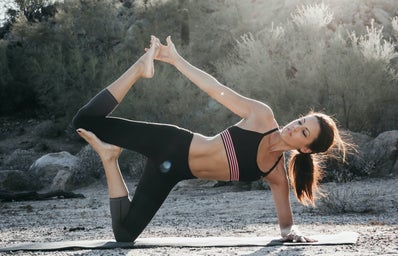This past December, I decided, as people do, that the holidays gave me a free pass to eat whatever I pleased. My diet that month consisted largely of Walkers shortbread cookies and elaborate holiday chocolates. But when December ends and January rolls around, the narrative shifts completely. Suddenly, you need to have goals and they almost always include a resolution to improve appearance or health. Although I strongly value health and wellness, the industry preys on our feelings of inadequacy. People search for quick fixes that will make them lose weight, have clearer skin, or achieve some type of glow they feel they previously lacked. Wellness magazines and publications never really teach someone how to establish and stick to a healthy routine, as this is done through education and discipline, but they do create plenty of trends that make people feel like they can purchase their health through a $60 juice cleanse. Some of these trends are useful and many of them have some sort of benefit. Some, however, accomplish goals that can be achieved through simpler (and far cheaper) means. I’m not any sort of expert in wellness, but I have tried most of these trends, and I’ll share what I’ve learned.
- Juice Cleanses (Celery Juice)
-
Juice cleanses are the most obnoxious wellness trend of all. And why wouldn’t you be obnoxious about a juice cleanse? After all, you’re living off of not even the fiber or flesh of fruits and vegetables, just the juice. Like a lot of wellness trends, juice cleanses provide the illusion that some major action is being taken to achieve a healthful life, but they embody the endless cycle of health fads and crashes encouraged by the industry. Juice cleanses have their benefits: they allow for greater vitamin consumption, help with digestion, and can be anti-inflammatory. All these things can also be accomplished by consistently eating vegetables and healthy food, and you can feel satiated as well.
- Silk Pillowcases
-
Silk pillowcases are hardly a recent trend. They feel very regal, like something Blair Waldorf or Marie Antoinette would use. Aside from aesthetic value, however, silk pillowcases are far better for your hair and skin than the average cotton pillowcase. Cotton is an absorbent material, so it’ll soak up the oils of your hair. People often complain about having oily hair, but that’s due to natural oils being stripped from overwashing—and absorbent cotton pillowcases—causing an overproduction of oil. I personally ordered a silk pillowcase when my hair started falling out more about a year ago (as the women washing my hair in a Pakistani salon candidly told me). Although this pillowcase wasn’t the only thing I changed about lifestyle, my hair has been a lot softer since. I especially recommend this for curly hair, as silk helps prevent frizz and keeps curls in their natural shape.
- Collagen Supplements
-
The other day, I found myself standing in MOM’s Organic Market, staring down a $20 three oz. bottle of collagen supplement powder, naively wondering if it would really give me the apparent eyebrow lift the before and after pictures showed. $20 was actually a relatively cheap price point. Collagen is a protein that the human body produces naturally, but, as we age, production slows down. That’s probably why the target market for these types of products are middle aged white women who probably worship Goop. Unfortunately, supplements like this aren’t regulated, so producers can make claims without having to show any real results. There hasn’t been a lot of research on ingesting collagen, but there is little to no evidence to suggest that the protein finds its way to the bloodstream where it would be useful. The best way to maximize collagen production is to eat a diet that includes vegetables and protein, particularly organ meats and bone broth, and to minimize your intake of refined sugar, which decreases collagen production. Stirring a tasteless powder into your coffee seems much more pleasant, but it probably won’t do much.
- Glass Straws
-
This isn’t necessarily a wellness trend—more like a climate-change-might-literally-end-life-as-we-know-it-within-15-years-what-can-we-do trend. Saying it’s difficult to live in a time period when climate change is becoming seemingly irreversible is an understatement. It can feel hopeless at times, as there are limited actions an individual can take. Those actions will have little to no impact on the severity of climate change and land degradation and forest destruction and ocean pollution. But we do them anyways. We order our glass straws and feel a small triumph that a sea turtle will not choke on a straw we used to sip our iced oat milk lattes. It’s a small action, but if it breeds hope, carry on. Just be sure to keep this spirit in other aspects of your life as well: eat less meat, buy local produce, use reusable grocery bags and water bottles.
- Having a 10+ Step Skin Care Routine
-
The biggest scam in the world is genetically blessed people with glass skin boasting about their skincare routines. On one end of the scale, you have people who act as if water will save you: “I just drink lots of water”; “In the morning I just wash my face with water. On the other end of the spectrum, you have people with perfect skin who do skincare for the pampering, luxurious quality. Obviously, both are fine, but if you have troubled skin, do not get your skincare advice from people who hardly had a zit in their entire teenagerhood. You do not need ten products. In my experience, you need a cleanser, toner, and moisturizer with spf. Serums and medications can be added as needed, and a mask every now and then is beneficial, but using ten different products on your face within the span of a day will probably just confuse your skin. Korean skincare, where the 10-step skincare routine originalized, is actually undergoing a new trend: “skip-care.” Imagine how betrayed you’d feel after splurging on a ten-step routine just to find out that Korean millennials themselves increasingly prefer a minimal approach to skincare.
- Kitchari Cleanse
-
The Kitchari cleanse is a recent trend developed from Ayurvedic healing practices. I have a South-Asian background, so I was astonished to find “kitchari kits” (essentially gentrified packages of lentils and rice) on wellness websites. Despite my problem with the appropriation of South-Asian culture prevalent in western wellness spheres (e.g. yoga), I do recommend the Kitchari cleanse. In my childhood, whenever I experienced an upset stomach, my mother or grandmother would feed me this combination of rice, lentils, and ghee until I felt better. It’s a very neutral food and aids in digestion, as lentils are rich in fiber.



